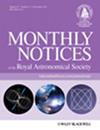Exploring the Evolution of Dust Temperature using Spectral Energy Distribution Fitting in a Large Photometric Survey
IF 4.7
3区 物理与天体物理
Q1 ASTRONOMY & ASTROPHYSICS
引用次数: 0
Abstract
Panchromatic analysis of galaxy spectral energy distributions, spanning from the ultraviolet to the far-infrared, probes not only the stellar population but also the properties of interstellar dust through its extinction and long-wavelength reemission. However little work has exploited the full power of such fitting to constrain the redshift evolution of dust temperature in galaxies. To do so, we simultaneously fit ultraviolet, optical and infrared observations of stacked galaxy subsamples at a range of stellar masses and photometric redshifts at 0 < z < 5, using an energy-balance formalism. However, we find UV-emission beyond the Lyman limit in some photometric redshift selected galaxy subsamples, giving rise to the possibility of contaminated observations. We carefully define a robust, clean subsample which extends to no further than z ∼ 2. This has consistently lower derived temperatures by $4.0^{+5.0}_{-1.9}$ K, relative to the full sample. We find a linear increase in dust temperature with redshift, with Td(z) = (4.8 ± 1.5) × z + (26.2 ± 1.5) K. Our inferred temperature evolution is consistent with a modest rise in dust temperature with redshift, but inconsistent with some previous analyses. We also find a majority of photometrically-selected subsamples at z > 4.5 under-predict the IR emission while giving reasonable fits to the UV-optical. This could be due to a spatial disconnect in the locations of the UV and IR emission peaks, suggesting that an energy-balance formalism may not always be applicable in the distant Universe.利用光谱能量拟合研究大型光度测量中尘埃温度的演变
从紫外到远红外的星系光谱能量分布的全色分析,不仅可以探测恒星种群,还可以通过星际尘埃的消光和长波再发射来探测星际尘埃的特性。然而,利用这种拟合的全部力量来限制星系中尘埃温度的红移演化的工作很少。为了做到这一点,我们同时使用能量平衡形式,在恒星质量和0 < z < 5的光度红移范围内,对堆叠星系亚样本进行紫外、光学和红外观测。然而,我们发现在一些光度红移选择的星系亚样本中,紫外线辐射超过了莱曼极限,从而产生了污染观测的可能性。我们仔细定义了一个健壮、干净的子样本,其延伸范围不超过z ~ 2。相对于整个样本,这使得导出的温度始终降低了$4.0^{+5.0}_{-1.9}$ K。我们发现尘埃温度随红移呈线性增加,Td(z) =(4.8±1.5)× z +(26.2±1.5)K。我们推断的温度演变与尘埃温度随着红移的适度上升是一致的,但与之前的一些分析不一致。我们还发现大多数在z > 4.5的光度选择的子样品在给出合理的紫外光学拟合的同时低估了红外发射。这可能是由于紫外线和红外线发射峰位置的空间脱节,这表明能量平衡的形式可能并不总是适用于遥远的宇宙。
本文章由计算机程序翻译,如有差异,请以英文原文为准。
求助全文
约1分钟内获得全文
求助全文
来源期刊

Monthly Notices of the Royal Astronomical Society
ASTRONOMY & ASTROPHYSICS-
CiteScore
9.10
自引率
37.50%
发文量
3198
审稿时长
3 months
期刊介绍:
Monthly Notices of the Royal Astronomical Society is one of the world''s leading primary research journals in astronomy and astrophysics, as well as one of the longest established. It publishes the results of original research in positional and dynamical astronomy, astrophysics, radio astronomy, cosmology, space research and the design of astronomical instruments.
 求助内容:
求助内容: 应助结果提醒方式:
应助结果提醒方式:


